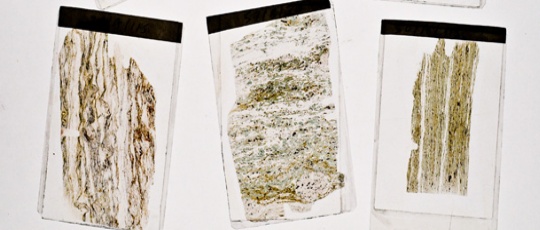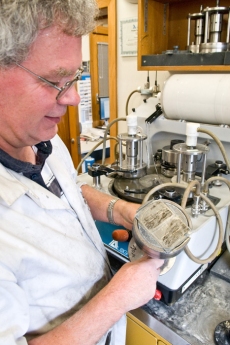Thin section laboratory

A thin section is a slice of material attached to a glass slide, enabling its structure to be examined microscopically. Thin sections are commonly made of rocks as well as fossils, metal, fish teeth and petrified wood.
Thin sections are useful for distinguishing types of igneous, sedimentary and metamorphic rocks and identifying minerals within them. This information is essential for interpreting geological processes and environments.

A microscope allows textural relationships in a specimen to be seen. Observing the microscopic relationships between mineral grains in igneous rocks allows the order in which minerals crystallised to be determined. Minerals produced by alteration in metamorphic rocks, deposition of sediment or weathering can also be identified.
Typically thin sections are 30 µm (0.03 mm) thick by 26 x 46 mm, although larger ones are also produced.
The main sizes (in mm) are:
- 28 x 48
- 25 x 75
- 52 x 75
Sections are generally covered by a cover slip, also attached to the rock with epoxy adhesive. The epoxy adhesive has a refractive index of 1.54, matched to the glass, to reduce refractive interference. For chemical analysis on an electron microprobe or Scanning Electron Microscope (SEM), the sections are polished and left uncovered.
Equipment

The School has a dedicated laboratory for making thin sections for teaching purposes and for research staff and students.
The laboratory has the following equipment:
- large rock cutting saw
- 2 bonding jigs – necessary to form a uniform ‘zero’ bond thickness between sample and glass slide
- trim saw to reduce glued section to a depth of 1000 microns
- diamond cup-wheel to pre-grind sections to approximately 80 microns
- Logitech LP50 for lapping the sections to 30 microns thick
- 2 ATM Saphir 560 polishing machines
